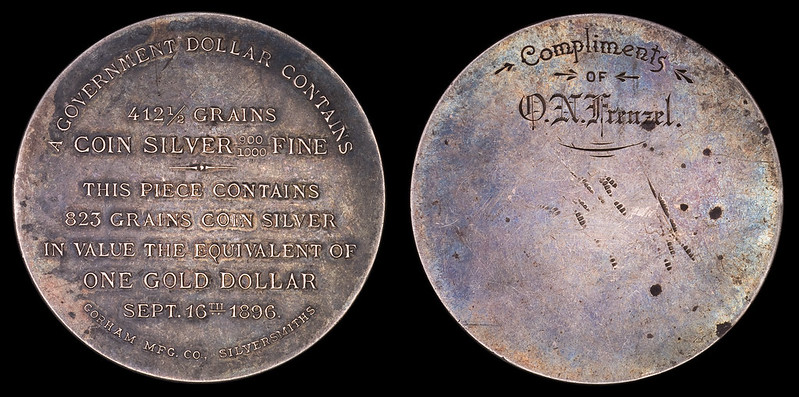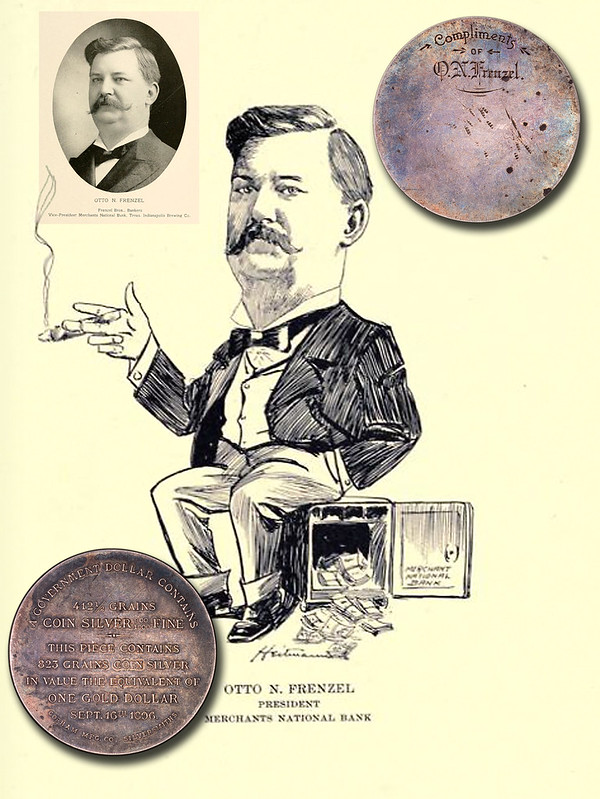So-Called Dollar Discussions
Bryan Dollars
Quote from Pioneer on February 27, 2013, 7:35 pmHK 781 is one of the most common of the Bryan dollars. 781 has the blank reverse (I kind of like the cartwheel reverse). Interesting and invaluable information--thank you But, there are interesting pieces to find even though the type is common. I recently acquired an example that was diagnosed as "damaged" because someone had engraved the reverse. It just so happens that these are collectible and not damaged.
The piece was compliments O.N. Frenzel. Note the "bag marks" below the engraving. Damage, yes. But these marks are silver dollar reeding marks. Ironic? So who was O.N. Frenzel. Otto Nicholas Frenzel and his older brother worked their way up in the Merchants' Bank of Indianapolis, each starting as "gofers" in their teenage years until brother John became President and Otto became vice president and cashier for the bank in 1896. Both were active in the Democratic Party, but both were hard money democrats and became active in the National Democratic Party who ran their own candidates following their national convention in Indianapolis in early September 1896. Brother John became the treasurer for the National Democratic Party. We associate these pieces today with the Republican Party and the anti-Bryan campaign, but this piece clearly demonstrates the National Democratic Party embraced them as well.
HK 781 is one of the most common of the Bryan dollars. 781 has the blank reverse (I kind of like the cartwheel reverse). Interesting and invaluable information--thank you But, there are interesting pieces to find even though the type is common. I recently acquired an example that was diagnosed as "damaged" because someone had engraved the reverse. It just so happens that these are collectible and not damaged.
The piece was compliments O.N. Frenzel. Note the "bag marks" below the engraving. Damage, yes. But these marks are silver dollar reeding marks. Ironic? So who was O.N. Frenzel. Otto Nicholas Frenzel and his older brother worked their way up in the Merchants' Bank of Indianapolis, each starting as "gofers" in their teenage years until brother John became President and Otto became vice president and cashier for the bank in 1896. Both were active in the Democratic Party, but both were hard money democrats and became active in the National Democratic Party who ran their own candidates following their national convention in Indianapolis in early September 1896. Brother John became the treasurer for the National Democratic Party. We associate these pieces today with the Republican Party and the anti-Bryan campaign, but this piece clearly demonstrates the National Democratic Party embraced them as well.
Quote from Bill Walter on February 5, 2014, 12:37 pmI am not an expert on Bryan Dollars, but I understand they were related the issue of bimetallism (monetary value ratio of gold to silver). When America was founded in the 1700, a ratio of 15 silver to 1 gold was chosen. In 1834, the ratio changed to 16:1, and at that time, this ratio resulted in silver being undervalued, and hence it was hoarded and disappeared from circulation. The US mint stopped coining silver dollars in 1873, much to the dismay of silver mine owners. Various efforts were made to restore silver as a standard without great success. In 1896 and 1900, William Jennings Bryan (a democrat) ran against William McKinley on the issue of bimetallism (to restore silver) and lost. Bimetallism was behind the Lesher dollars, Pedley-Ryan dollars, and various western state silver SCDs in the 1930s. Bryan dollars (HK-777 to HK-786, HK-1010 to HK-1015) were struck to show the increased size that a silver dollar would need to be if Bryan won the presidency and instituted his platform. In essence, they were pieces made to convince people NOT to vote for Bryan. Bryan dollars seem to be somewhat popular as of late to collectors. I see them selling reasonably well. They appear to have been made/released by companies like Tiffany & Co, Gorham Mfg. Co Silversmiths, E Jaccard & Co, Spaulding & Co. Many of these SCDs are typically found in XF-AU condition and average $300 apiece. The most common pieces are HK-780, 781, 783, and 786, averaging $350 in UNC condition and $500 in choice UNC condition, and $700+ in GEM condition. The rarest pieces include HK-1010, 1012, 1014, and 1015? with single digit populations and prices potentially into the thousands. Restrikes of several of these SCDs were made in 1910 with frosted surfaces and slightly larger company lettering as outlined in the H&K book. For more detailed information, the 2001 book by Fred Schornstein titled "Bryan Money" (available through the Token & Medal Society [TAMS]) has an excellent photographic collection of the breadth of Bryan Money. I own a copy for the images and specs on these pieces.
I am not an expert on Bryan Dollars, but I understand they were related the issue of bimetallism (monetary value ratio of gold to silver). When America was founded in the 1700, a ratio of 15 silver to 1 gold was chosen. In 1834, the ratio changed to 16:1, and at that time, this ratio resulted in silver being undervalued, and hence it was hoarded and disappeared from circulation. The US mint stopped coining silver dollars in 1873, much to the dismay of silver mine owners. Various efforts were made to restore silver as a standard without great success. In 1896 and 1900, William Jennings Bryan (a democrat) ran against William McKinley on the issue of bimetallism (to restore silver) and lost. Bimetallism was behind the Lesher dollars, Pedley-Ryan dollars, and various western state silver SCDs in the 1930s. Bryan dollars (HK-777 to HK-786, HK-1010 to HK-1015) were struck to show the increased size that a silver dollar would need to be if Bryan won the presidency and instituted his platform. In essence, they were pieces made to convince people NOT to vote for Bryan. Bryan dollars seem to be somewhat popular as of late to collectors. I see them selling reasonably well. They appear to have been made/released by companies like Tiffany & Co, Gorham Mfg. Co Silversmiths, E Jaccard & Co, Spaulding & Co. Many of these SCDs are typically found in XF-AU condition and average $300 apiece. The most common pieces are HK-780, 781, 783, and 786, averaging $350 in UNC condition and $500 in choice UNC condition, and $700+ in GEM condition. The rarest pieces include HK-1010, 1012, 1014, and 1015? with single digit populations and prices potentially into the thousands. Restrikes of several of these SCDs were made in 1910 with frosted surfaces and slightly larger company lettering as outlined in the H&K book. For more detailed information, the 2001 book by Fred Schornstein titled "Bryan Money" (available through the Token & Medal Society [TAMS]) has an excellent photographic collection of the breadth of Bryan Money. I own a copy for the images and specs on these pieces.
Quote from billycgribble on November 17, 2015, 6:52 pmHK 781 is one of the most common of the Bryan dollars. 781 has the blank reverse (I kind of like the cartwheel reverse). But, there are interesting pieces to find even though the type is common. I recently acquired an example that was diagnosed as "damaged" because someone had engraved the reverse. It just so happens that these are collectible and not damaged.
The piece was compliments O.N. Frenzel. Note the "bag marks" below the engraving. Damage, yes. But these marks are silver dollar reeding marks. Ironic? So who was O.N. Frenzel. Otto Nicholas Frenzel and his older brother worked their way up in the Merchants' Bank of Indianapolis, each starting as "gofers" in their teenage years until brother John became President and Otto became vice president and cashier for the bank in 1896. Both were active in the Democratic Party, but both were hard money democrats and became active in the National Democratic Party who ran their own candidates following their national convention in Indianapolis in early September 1896. Brother John became the treasurer for the National Democratic Party. We associate these pieces today with the Republican Party and the anti-Bryan campaign, but this piece clearly demonstrates the National Democratic Party embraced them as well.
HK 781 is one of the most common of the Bryan dollars. 781 has the blank reverse (I kind of like the cartwheel reverse). But, there are interesting pieces to find even though the type is common. I recently acquired an example that was diagnosed as "damaged" because someone had engraved the reverse. It just so happens that these are collectible and not damaged.  The piece was compliments O.N. Frenzel. Note the "bag marks" below the engraving. Damage, yes. But these marks are silver dollar reeding marks. Ironic? So who was O.N. Frenzel. Otto Nicholas Frenzel and his older brother worked their way up in the Merchants' Bank of Indianapolis, each starting as "gofers" in their teenage years until brother John became President and Otto became vice president and cashier for the bank in 1896. Both were active in the Democratic Party, but both were hard money democrats and became active in the National Democratic Party who ran their own candidates following their national convention in Indianapolis in early September 1896. Brother John became the treasurer for the National Democratic Party. We associate these pieces today with the Republican Party and the anti-Bryan campaign, but this piece clearly demonstrates the National Democratic Party embraced them as well.
The piece was compliments O.N. Frenzel. Note the "bag marks" below the engraving. Damage, yes. But these marks are silver dollar reeding marks. Ironic? So who was O.N. Frenzel. Otto Nicholas Frenzel and his older brother worked their way up in the Merchants' Bank of Indianapolis, each starting as "gofers" in their teenage years until brother John became President and Otto became vice president and cashier for the bank in 1896. Both were active in the Democratic Party, but both were hard money democrats and became active in the National Democratic Party who ran their own candidates following their national convention in Indianapolis in early September 1896. Brother John became the treasurer for the National Democratic Party. We associate these pieces today with the Republican Party and the anti-Bryan campaign, but this piece clearly demonstrates the National Democratic Party embraced them as well. 